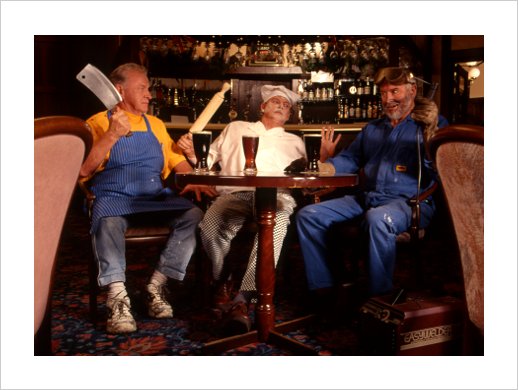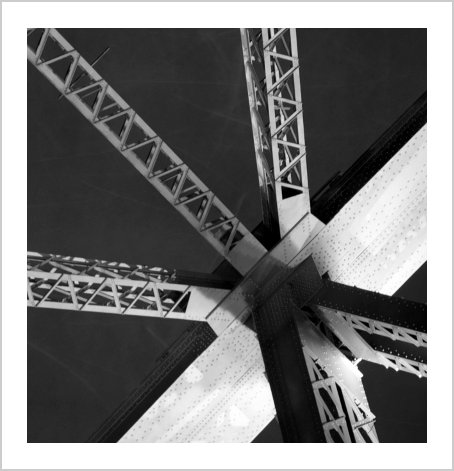Monthly Archives: April 2009
Rub-a-dub-dub

In my first year of as a commercial photographer, I wanted to make a dedicated image to put on my client christmas cards, something that spoke to creativity and technical proficiency. Somehow I came up with ‘Rub a dub dub, three men in a pub’ and convinced a pub and five people to help me make it. The butcher really was the local butcher, the baker is my uncle and the suitably mad candlestick maker a friend from church. Makeup was done by a student artist and another friend helped me move all the gear.
The only natural light in the scene is the light globe at the very top right. The foreground was lit with three studio strobes, including a (then) brand new type of light reflector that provided a large, directional light source to simulate sunlight (through the windows of the bar). The background (the bottles in the bar) were lit with a typical camera flash unit on a slave trigger and a sparkler was lit to create a welding spark.
I still don’t know what I think of this image – as I made it completely from scratch it’s one of the images I feel most naked showing to other people. It took a long time to make and used more of the models’ time than I had hoped, particularly the butcher who needed to get back to his shop (and he couldn’t even drink his beer because I’d put salt in it to keep its head). Plus there are a number of technical flaws that I won’t point out but personally can’t ignore. Fortunately, however, my clients loved it.
Hate me, but don’t ignore me
This 4 minute Cool Hunting video looks at Sao Paulo’s prolific graffiti artists:
- tags made without the risk of climbing are not valued (this tribe demands commitment from its participants),
- the tag is made up of a personal symbol, a gang symbol and the date (the artist is claiming current membership in their gang, and presumably ownership of a neighbourhood),
- the artists are the invisible poor who say ‘I’d prefer you to hate me than ignore me’ (to me the most significant point here),
- the tags are in a common style that dates back to the 1980s (the artists are aligning themselves with each other even over gang boundaries and the tags only understandable only by those in the culture),
- the symbols are based on the logos of heavy metal bands (the artists belong to a wider tribe – youths around the world who have an affinity with heavy metal presumably because it expresses their feelings), and
- the artists don’t know why they do it (self-awareness is a not a prerequisite to action against deeply held values).
Generosity
As the web has exploded, so has generosity. I think there’s at least three kinds of generosity that we see today:
I can’t use it so you have it.
This is where the giver can’t benefit directly from what they own and therefore gives it freely, often to obtain an indirect or non-tangible benefit. Two examples might be the author who gives away part of a book to increase book sales, and the blogger who gives away small ideas in the hope of building a reputation or tribe.
I won’t miss it.
This is where the giver could directly benefit from what they own but it represents only a marginal benefit to them (and therefore only a marginal cost to give it away). The patronage of the wealthy, tipping and a $25 loan on kiva.org might be good examples.
Your need is more important than mine.
This is the traditional view of generosity, where the giver gives in spite of incurring a significant personal cost to do so.
Proportionally speaking, the vast majority of generosity used to be either ‘I won’t miss it’ by the very wealthy or ‘your need is more important than mine’ because prior to the web the costs of facilitating gift-giving were very high, making the smaller transactions inefficient. Sharing an idea with the public required buying media so only the most important ideas were shared. The end-to-end cost of completing a gift transaction meant that only large gifts were efficient. And the cost of near-perfect information (will my intended recipient receive my gift?) meant that certainty was available only for the large foundations or large-scale charities who could afford to chase this information down. These inefficiencies prevented the smaller scale and ‘I can’t use it so you have it’ generosity that we see today.
Are all three kinds true generosity, however? I’m a traditionalist here – I think true generosity is ‘your need is more important than mine’, where the giver incurs a real cost in making their gift. Regardless, all three forms of generosity should be valued not as moral credit to the giver but as realised benefit to the recipient – even something useless to the giver can be another person’s treasure. Whatever the giver’s motivation or cost, we can all be thankful for the explosion in generosity that we enjoy today.
p.s. Clay Shirky has some good thoughts on designing for generosity which have no doubt inspired mine.
Harbour Bridge

